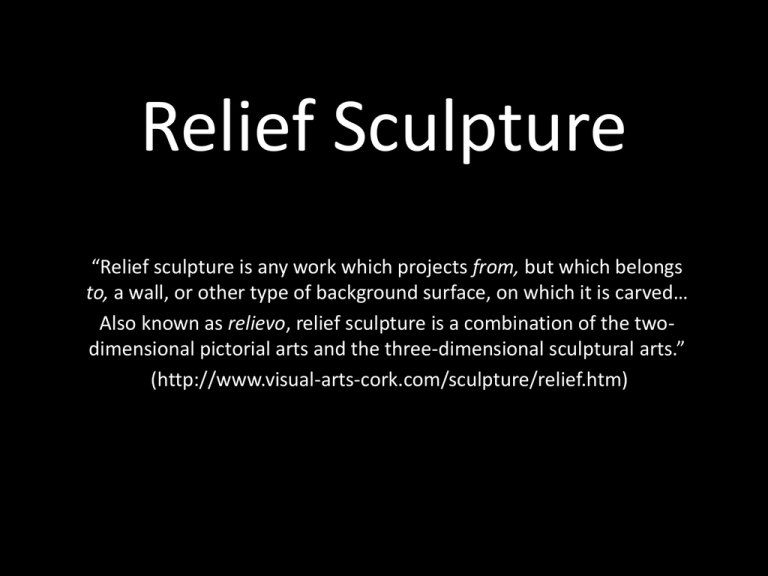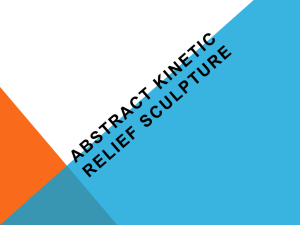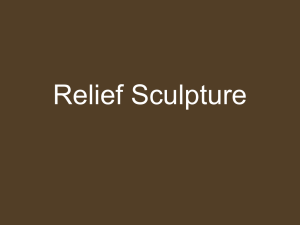Relief Sculpture
advertisement

Relief Sculpture “Relief sculpture is any work which projects from, but which belongs to, a wall, or other type of background surface, on which it is carved… Also known as relievo, relief sculpture is a combination of the twodimensional pictorial arts and the three-dimensional sculptural arts.” (http://www.visual-arts-cork.com/sculpture/relief.htm) Relief Sculpture • The term relief is from the Latin verb levo, to raise. To create a sculpture in relief is to give the impression that the sculpted material has been raised above the background plane. • There are four different types of relief : – high relief= Where more than 50% of the depth is shown and there may be undercut areas. – mid-relief = Not enough detail to be considered high, but also has more depth than low relief. – low-relief (French: bas-relief), where the plane is scarcely more than scratched in order to remove background material. – sunken relief (aka incised or intaglio relief), where the carving is sunk below the level of the surrounding surface. If you look at it from the side, you cannot see the carving. Sunken relief is surrounded by a carved frame. This frames the carving with a powerful line of shadow. The surrounding surface remains untouched, with no projections. Sunken relief carving is found almost exclusively in ancient Egyptian art, although it has also been used in some beautiful small-scale ivory reliefs from India. Relief Methods in Clay • Additive Relief – Adding to the field to raise the subject and increase depth. – For example clay, plaster can be built up to make a sculpture into a relief. • Subtractive Relief - Carve Away or subtract from the field to lower the background and raise the plain. – For example you can carve into clay or plaster to make a sculpture into relief. What type of relief to you think it is? Guess on the following image examples. High, Medium, Low, or Sunken? Prehistoric Relief Sculpture Reliefs date from the Gravettian Period (28,000 to 22,000 years ago) of the Paleolithic era. Next three examples of relief are all from the Gravettian Period. The Venus of Laussel (c.23,000-20,000 BCE), a limestone low relief of a reclining female figure, found in the Dordogne, France. This limestone carving is one of the earliest relief sculptures, & ranks among the world's oldest artworks. The low relief depiction of salmon Found in the Abri du Poisson Cave (c.23,000-20,000 BCE) At Les Eyzies de Tayac, Périgord, Dordogne, France This is one of the oldest known representations of fish in the world The outline around the fish, is formed by thieves trying to steal the carving in the 70’s The Tuc d'Audoubert Bison (c.13,500 BCE) This is an unfired clay relief sculptures of two bison from the Magdalenian Period. Discovered at Tuc d'Audoubert Cave, Ariege, France. Ancient World reliefs (3,500-600 BCE) An example of low relief artworks discovered from the ancient world are the set of lions and dragons from the Ishtar Gate, Babylon. (Images on next 2 slides) Babylon was once the greatest city of the world when the Neo-Babylonian Empire reigned supreme in the Ancient Near East (575 B.C.) Ishtar Gate detail (575 B.C.E) Ancient World reliefs (3,500-600 BCE) An example of sunken relief artworks discovered from the ancient world are in Egypt. Egyptian sculptors tended to employ sunken relief. Figures are depicted standing sideways and are contained within a sharply insized outline: see for instance the many sunken reliefs at the Temple of Karnak in Egypt. (Image on next slide) Relief at the Temple of Karnak – Egypt Questions to discuss • What do you think the oldest sculptures found in France were used for? (The salmon, the buffalo, and the reclining woman.) Why were they made? • In the ancient world and in Ancient Egypt, reliefs were used to decorate buildings, tell stories, and communicate areas and persons of importance. Where did they learn to create these sculptures? How long do you think it took to carve into stone? Ancient Relief Sculpture • High reliefs did not become common until Classical Antiquity (c.500 BCE onwards), when Ancient Greek sculptors began to explore the genre more thoroughly. – Attic tomb relief sculpture dating from the 4th century BCE are notable examples, as are the sculptured friezes used in the decoration of the Parthenon and other classical temples. – During the period 600-1100, abstract reliefs appeared in numerous cultures around the world, as disparate as the Mixtec culture in Mexico, the Norse/Viking culture and Islamic environments across the Middle East. Jumping forward in Time… From Ancient world 3,500-600 BCE to Ancient Greece (776 BCE – 400 BCE) Relief Sculpture were used mainly on walls, friezes, and grave markers (called ‘stele’). More popular form of sculptures had risen. Doing artwork “in the round” (free standing) was used to trade with, show importance, and show skill level beyond relief. The reliefs that were made were high reliefs, cut almost in the round, to keep up with the trending forms. (Example on next pages) Stele of Pamphile & Demetrias Late 4th century BCE In the sculpture, Pamphile is seated on a throne, extending her hand to her sister Demetrias, who is standing. High Relief. This sculpture is one of the last ones made, before the issue of the prohibited law by Demetrious Phalereus in 317 BC. This outlawed lavished over the top grave markers like this one. Greece becomes a Rome Province 146 BCE As Roman culture, and styles over lapped with Greek, they too had a fascination with the use of high relief on walls, friezes, grave markers, and also on sarcophagi (tombs). Relief sculptures were prominent in the sarcophagi of Roman art during the 2nd and 3rd centuries CE. Roman sarcophagus, Italy, mid 2nd century CE - Nelson-Atkins Museum of Art. Exhibit in the Nelson-Atkins Museum of Art, Kansas City, Missouri, USA. We will discuss the rest at a later time…….That’s enough history for today! Follow the next two slides for what to do next. Project Goals (Write these down) • To create a relief sculpture no smaller than 8.5”x5.5”. • To use varying degrees of high and low relief to create a 3D sculpture on a 2D plane. • Use both additive and subtractive methods to create details and forms • Create a strong piece that will not break when transported or fired. • Using creativity, and time to create a strong artwork • Create a piece with at least one subject matter and an visible background with details. • You may choose whether your work is abstract, or real. • You may choose whether your work is functional or non-funtional • You may choose in what direction your piece will be displayed. – Ex. Sits on a table, hangs from a wall, hooks to a countertop, wraps around a mug. Steps • TODAY: Sketch your ideas out, both from the front and side view. Think of how layers and depth are needed to create the illusion of 3D work. I want to see 3 different ideas. Describe whether it will be functional or non-functional. Also describe visually the shapes. • TODAY: After you have your idea down, create a slab of clay on which to work. Remember size rules. (no smaller than 8.5x5.5) • NEXT CLASS: You can either add to your slab or create your piece separate and attach at a later time. If you use the subtractive method, remember to wrap clay that is subtracted together and keep it damp. • Work on a clay board! Your piece will be difficult to move!






